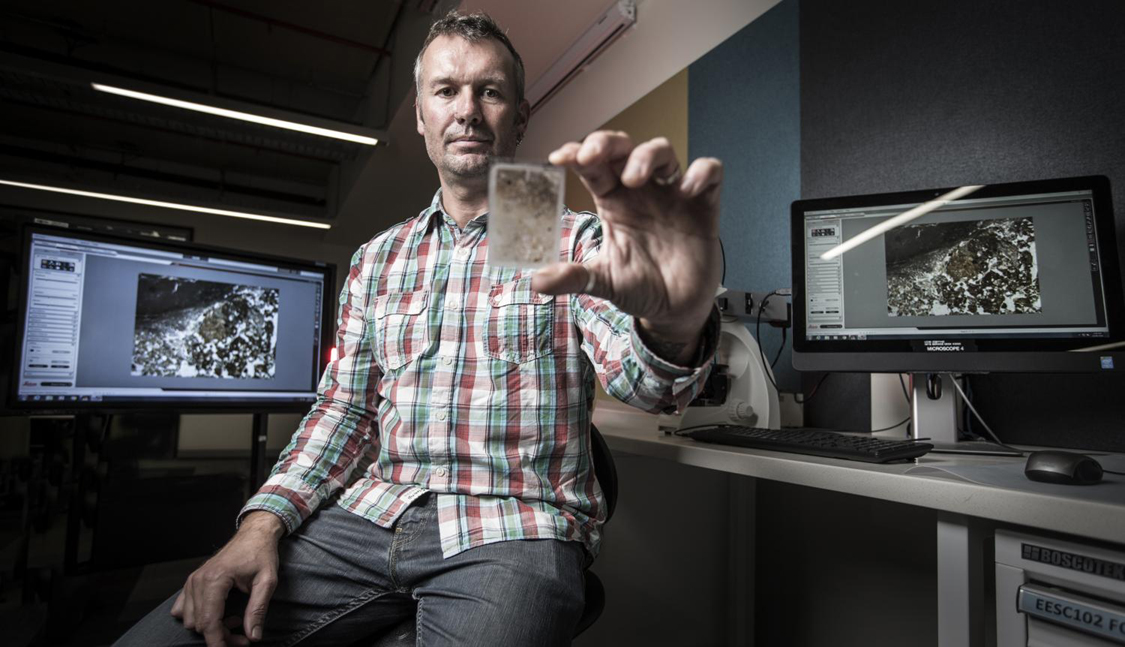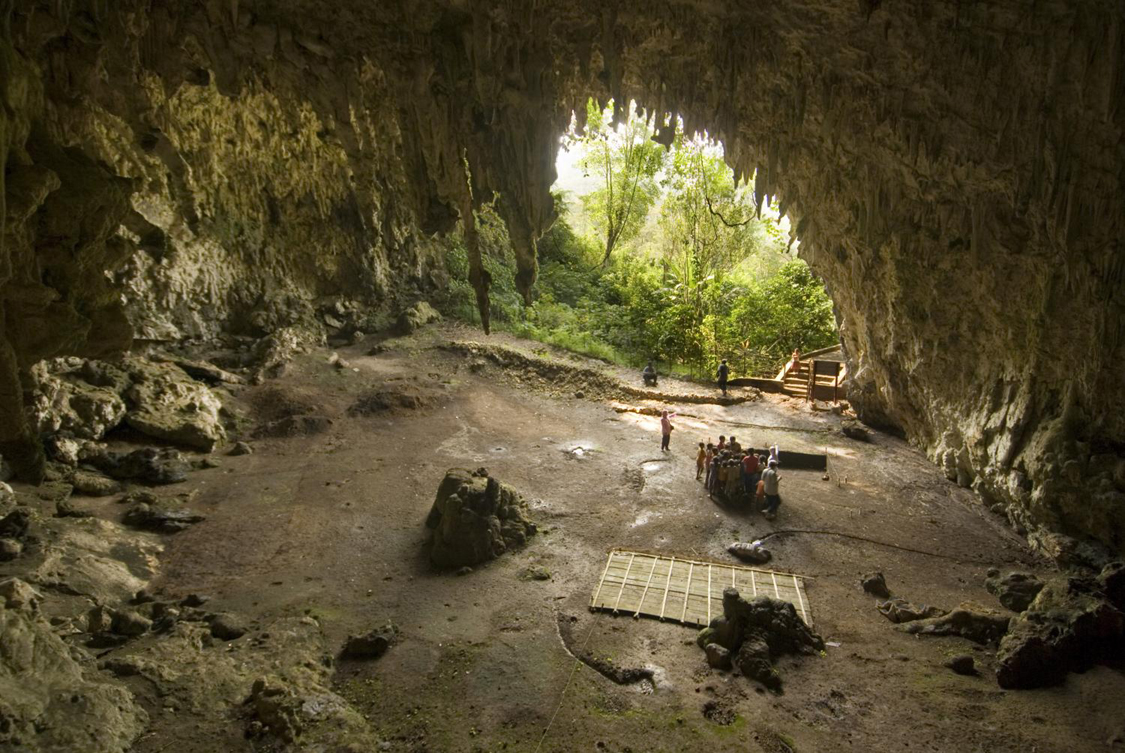


An article on phys.org provided by the University of Wollongong - Fire discovery sheds new light on 'hobbit' demise - reports on the crucial new evidence which reveals modern humans (Homo sapiens) were likely using fire at Liang Bua 41,000 years ago, narrowing the time gap between the last hobbits (Homo floresiensis) and the first modern humans at this site on the Indonesian island of Flores.

Dr Mike Morley, from the University of Wollongong, Australia, with a sediment sample taken from Liang Bua. Image: Paul Jones | University of Wollongong.
The research, led by the University of Wollongong Australia (UOW) and Indonesia's National Research Centre for Archaeology and published recently in the Journal of Archaeological Science, is among the earliest evidence of modern humans in Southeast Asia.
Fire discovery may shed new light on #hobbit demisehttps://t.co/FxOx7oLNtQ #archaeology #Flores pic.twitter.com/B8tx95SLzG
— Bradshaw Foundation (@BradshawFND) June 30, 2016
Lead author Dr Mike Morley, a research fellow and geoarchaeologist at UOW's Centre for Archaeological Science (CAS), states that the find is "extremely important" in the quest to discover why and how the 'hobbit' disappeared, around 50,000 years ago.
After revised dating estimates of the original hobbit skeleton - published in Nature in March (see link below) - placed the bones between 190,000 and 60,000 years old (it was previously believed to have survived on Flores until as recently as 12,000 years ago), and the most recent stone tools at 50,000 years old, a gap in the chronology of the sediment sequence opened up - researchers had no idea what happened at the site between 46,000 and 20,000 years ago.
Dr Morley and colleagues, including CAS geoarchaeologist Professor Paul Goldberg and archaeologist Thomas Sutikna, may have the answer. Environmental changes at the site between 190,000 and 20,000 years ago reveal physical evidence of fire places that were used between 41,000 and 24,000 years ago, most likely by modern humans for warmth and/or cooking.
Dr Morley states that we now know that the hobbits only survived until around 50,000 years ago at Liang Bua. We also know that modern humans arrived in Southeast Asia and Australia at least 50,000 years ago, and most likely quite a bit earlier. This new evidence, which is some of the earliest evidence of modern human activity in Southeast Asia, narrows the gap between the two hominin species at the site.

The limestone cave of Liang Bua on the indonesian island of Flores. Image: University of Wollongong.
Given that no evidence for the use of fire by Homo floresiensis during roughly 130,000 years of presence at the site has been found, Dr Morley said modern humans are the most likely candidates for the construction of the fire places.
Dr Morley said researchers at Liang Bua are now searching for more evidence that further closes that gap in time; evidence that could place modern humans at exactly the right place, at the right time, possibly revealing an overlap between the two species, which could have led to interaction between the two species and ultimately the hobbit's extinction.
As part of the study, Dr Morley used a technique called micromorphology to examine the sediments taken from the site at a microscopic level of detail. After extracting sediment blocks from the rear of the cave (a different area from where the hobbit fossils were recovered), the samples were shipped back to UOW and wafer-thin slices, just 30microns thick (1 micron is 1000th of a millimetre), were analysed under a microscope. Spectroscopic analyses of the sediments were made by CAS archaeological chemist Dr Linda Prinsloo, and new radiocarbon dates were used to determine the age of each layer examined for the study.
The study, which also acts as further evidence of Homo sapiens dispersal through Southeast Asia and into Australia around 50,000 years ago, comes just weeks after UOW researchers, also from CAS, announced they had found 700,000 year old fossilised remains of what appear to be ancestors of the hobbit.
The remarkable finds quash any remaining doubt that Homo floresiensis was a modern human afflicted with a disease causing the diminutive stature.
http://www.bradshawfoundation.com/news/origins.php?id=-Hobbit-ancestors-shrank-rapidly
by Bradshaw Foundation
Monday 04 December 2023
by Bradshaw Foundation
Friday 30 June 2023
by Bradshaw Foundation
Thursday 06 April 2023
by Bradshaw Foundation
Thursday 24 November 2022
by Bradshaw Foundation
Tuesday 27 September 2022
by Bradshaw Foundation
Thursday 08 September 2022
by Bradshaw Foundation
Tuesday 19 July 2022
by Bradshaw Foundation
Monday 06 June 2022
by Bradshaw Foundation
Friday 11 March 2022
by Bradshaw Foundation
Wednesday 02 March 2022
by Bradshaw Foundation
Thursday 26 August 2021
by Bradshaw Foundation
Monday 16 August 2021
by Bradshaw Foundation
Tuesday 06 July 2021
by Bradshaw Foundation
Thursday 06 May 2021
by Bradshaw Foundation
Thursday 06 May 2021
by Bradshaw Foundation
Tuesday 16 March 2021
by Bradshaw Foundation
Monday 04 December 2023
by Bradshaw Foundation
Friday 30 June 2023
by Bradshaw Foundation
Thursday 06 April 2023
by Bradshaw Foundation
Thursday 24 November 2022
by Bradshaw Foundation
Tuesday 27 September 2022
by Bradshaw Foundation
Thursday 08 September 2022
by Bradshaw Foundation
Tuesday 19 July 2022
by Bradshaw Foundation
Monday 06 June 2022
by Bradshaw Foundation
Friday 11 March 2022
by Bradshaw Foundation
Wednesday 02 March 2022
by Bradshaw Foundation
Thursday 26 August 2021
by Bradshaw Foundation
Monday 16 August 2021
by Bradshaw Foundation
Tuesday 06 July 2021
by Bradshaw Foundation
Thursday 06 May 2021
by Bradshaw Foundation
Thursday 06 May 2021
by Bradshaw Foundation
Tuesday 16 March 2021
Friend of the Foundation











